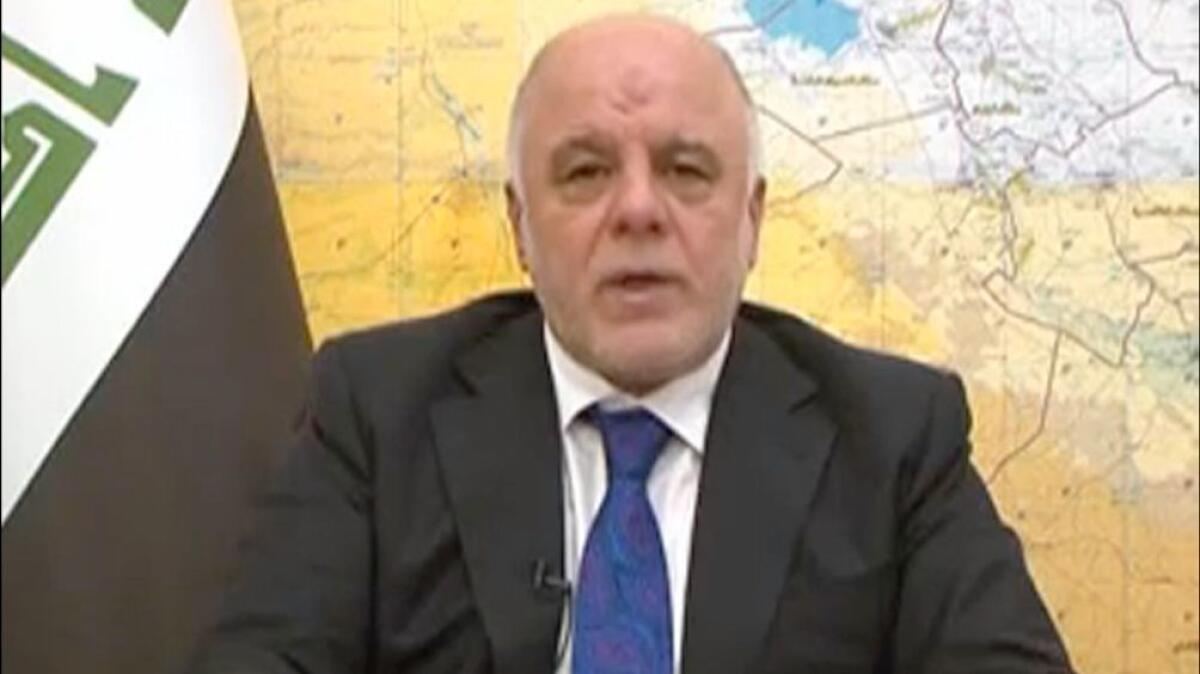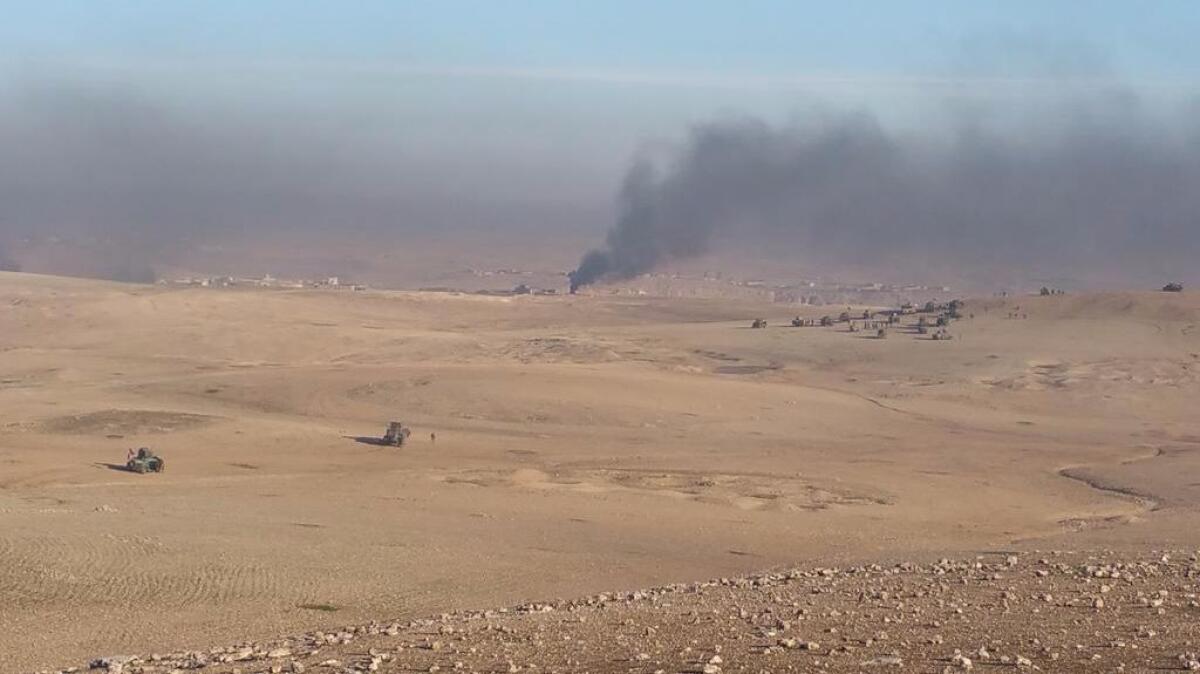Gritty clashes mark what Iraq hopes will be ‘the dawn of a great victory’ in Mosul

The Mosul campaign begins again. (Video by Nabih Bulos / Los Angeles Times)
- Share via
Reporting from LAZAKAH, Iraq — The sniper’s bullet hissed like a sharp exhalation of breath, scattering the clump of soldiers observing the battle unfolding down the hill. They ran, stumbling over stones as they raced for a row of vehicles behind them. Another hiss came. They ran faster.
“The sister of a whore, he’s too far. We can’t hear where the shot is coming from,” said one soldier as he ducked behind a Humvee, smiling as he cursed.
Another wondered if the helicopters swooping overhead had destroyed a car, presumed to be driven by an Islamic State suicide bomber, that had disappeared from view moments before.
A 60-foot-high plume of smoke rocketing into the sky was his answer. A beat later came the shock wave, followed by the roar of the blast.
The Iraqi soldier raised his arm to shield his eyes. “Shrapnel,” he said by way of explanation.

Fighting was heavy Sunday as the Iraqi military, aided by U.S. special forces, launched the second phase of its campaign to drive out Islamic State from the western half of Mosul. In a televised speech, Iraqi Prime Minister Haidar Abadi hailed the offensive as “the dawn of a great victory.”
“We [call upon] our heroic forces to mobilize with all bravery … to liberate what remains of this city and the citizens … and to rid them of Daesh forever,” he said, employing the Arabic acronym for Islamic State.
The battle for Mosul, which Islamic State seized in mid-2014, began in October when Iraqi troops punched their way into the city’s eastern districts. It took them 100 days to reach the Tigris River, which bisects the city and now forms one of the launching points for government forces bearing down on the west.
It was a grueling fight — and the final phase promises to be even harder. The jihadists’ weapons of choice — car bombs, suicide bombers and snipers — inflicted casualty rates as high as 50% for some units, reports said. The government declared the eastern bank liberated on Jan. 24, but paused the offensive to give security forces a chance to recuperate.
More than three weeks later, as dawn approached on Sunday, hundreds of vehicles from the Federal Police and Emergency Response Division rumbled their way to the village of Lazakah. It would be the staging point for the approximately six-mile run to the town of Albu Sayf, on the southern outskirts of Mosul. There they would be joined by other forces advancing toward the village of Athbah on the Baghdad-Mosul highway before entering the city’s western flank.

What began as a celebratory jaunt through the desert, with vehicles festooned with flags and a pickup blaring patriotic songs, abruptly changed just beyond Lazakah when the militants began shooting. The columns of vehicles stopped, waiting as helicopters burped heavy machine gun fire and launched rockets at the militants.
“We don’t know how many of these snipers there are down there, but we don’t think it’s more than 10 fighters,” said Lt. Yarub Mhanni, looking down at a dust-covered clump of structures.
Although this skeleton force of Islamic State fighters would offer little more than token resistance, Mhanni said, it would nevertheless be hard to advance.
“If there’s a sniper, they’ll stop us. In eastern Mosul, one of them stopped us for an entire day and I got shot in the leg.”
As the soldiers pushed on, U.S. special forces in fearsome MRAPs (a mine-resistant, ambush-protected vehicle) were giving fire support near the front line, while others consulted with Iraqi commanders on setting up defensive positions.
Despite the sight of U.S. special forces in the fray (U.S. officials insist American servicemen in Iraq are not in harm’s way), Defense Secretary James N. Mattis said Sunday during a visit to Arab allies in Abu Dhabi that there had been no change to rules of engagement regarding U.S. forces’ role in the Mosul operation since President Trump took office.
He plans to present the White House with a more aggressive plan to combat Islamic State by month’s end, he said, but acknowledged that U.S. airstrikes pounded Islamic State targets in western Mosul in the days ahead of the Iraqi assault, hitting militant command and control facilities.
U.S. pilots say the airspace above western Mosul is thick with aircraft. At any given time, up to 50 warplanes are flying in an increasingly compressed area.
Many of the aircraft are drones scouring for targets. The overhead imagery and intelligence that’s captured is relayed to air commanders who line up coalition fighter jets to strike and help the advance of Iraqi forces on the ground.
“We’re focused on intelligence collection to make sure the Iraqis are successful in this mission,” said Air Force Brig. Gen. Chuck Corcoran, an air commander at an undisclosed base in the region.
Air Force Lt. Col. August “Pfoto” Pfluger, an F-22 pilot and squadron commander, said American pilots have been operating over a compact area where dozens of strike aircraft circle high above western Mosul, which is more densely populated than the east side of the city.
“Eastern Mosul was a little more open,” he said. “You could look out and identify things like Mosul University. In the west, it’s a high-density environment. People live in apartment buildings and areas that are in much closer quarters.”
Pilots have to remain mindful of the risk of hitting civilians, which has grown in western Mosul as the militants mix among communities and take up fighting positions inside mosques, schools and hospitals.
The U.S.-led coalition said Saturday that warplanes had destroyed a building in a sprawling medical complex that was suspected to be repurposed as a Islamic State command hub. The extremist group later disputed the claim, saying the coalition airstrike killed 18 civilians, including women and children, and wounded 47 others.
U.S. air commanders insist that any building hit with an airstrike is watched for days to diminish the chance civilians are killed.
By the end of the day, the Joint Operations Command announced that Iraqi forces had seized a number of villages before Albu Sayf, and would soon head for Mosul’s airport. It would be the prelude to entering western Mosul, where narrow walkways and alleys will force security forces to abandon their vehicles and clear densely populated areas on foot.
Aid groups, however, fear that the difficulties may push units to forgo the restraint that had marked the assault on eastern part of the city, where many neighborhoods were spared wholesale destruction.
“The ultimate success of the offensive will be judged not on how many districts and villages are taken back but on how well Iraqi forces and the U.S.-led coalition protect civilians in the coming weeks and months,” Wolfgang Gressmann, Iraq director of the Norwegian Refugee Council, said in a statement Sunday.
“It would be a Pyrrhic victory for Iraq if west Mosul is brought back under government control at the expense of the lives of all those who have suffered under [Islamic State’s] horrific rule for nearly three years.”
Meanwhile, the U.N. has also warned that the estimated 750,000 to 800,000 people remaining in western Mosul face acute shortages and have little access to clean drinking water and electricity.
On Friday, Islamic State released a series of images on social media purporting to show Mosul’s markets. Bearded men peruse stalls, including one where an old man is preparing pickles.
And as a preview of what government troops will face, the group also released other photos offering a glimpse into the lives of “those keeping watch in southern Mosul,” where fighters loaded weapons, cooked meals and watched Islamic State propaganda videos in what appeared to be bunkers.
In thousands of leaflets thrown into Mosul before Sunday’s attack, the government said its troops were “determined to win.”
“The days in which ignorant people reigned over your storied Mosul are over,” it read.
“Prepare to greet the sons of your armed forces and to cooperate with them as your brothers did in the [eastern] side, so as to reduce losses and hasten victory.”
Special correspondent Bulos reported from Lazakah, Iraq, and staff writer Hennigan from Abu Dhabi, United Arab Emirates.
ALSO
In the half of Mosul freed from Islamic State, life returns to not-quite normal
In Arab world, fresh doubts about the chances for a Palestinian state
A tale of two cities: What happened when factory jobs moved from Warren, Ohio, to Juarez, Mexico
More to Read
Sign up for Essential California
The most important California stories and recommendations in your inbox every morning.
You may occasionally receive promotional content from the Los Angeles Times.









